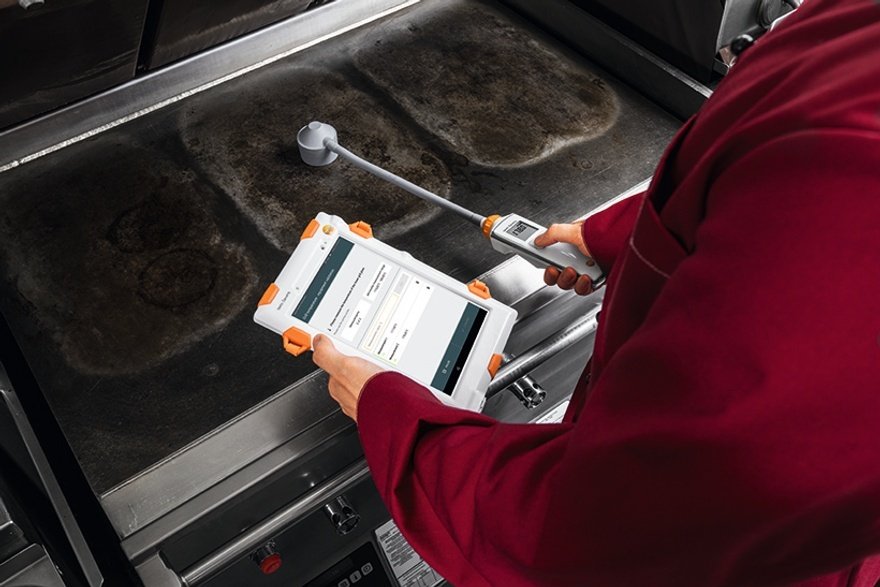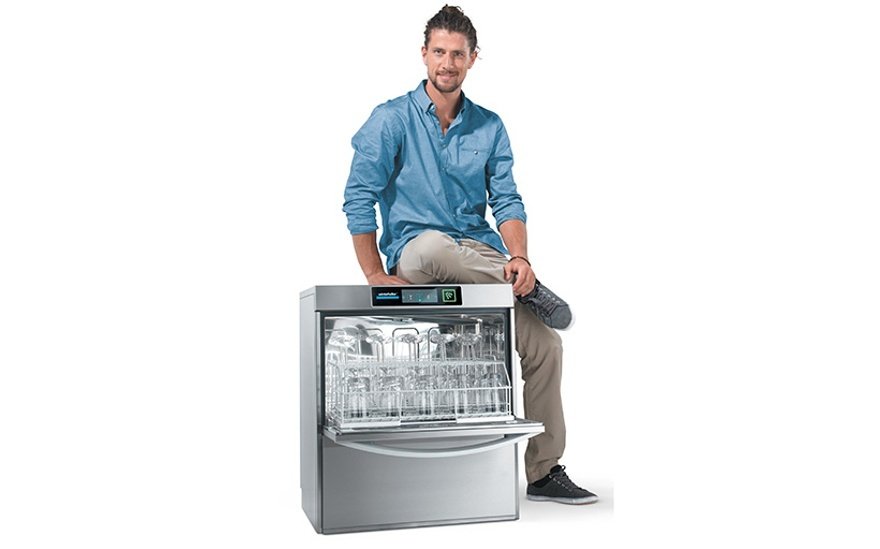With the coronavirus crisis amplifying the need for reliable hygiene protocols, the spotlight is now on temperature monitoring and HACCP requirements. Angela Frewin finds out which equipment and technology can help
"Meeting HACCP (hazard awareness critical control point) requirements is more important than ever in light of the Covid-19 pandemic," advises John Whitehouse, chair of the Foodservice Equipment Association (FEA). It is perhaps a prime time for foodservice operators to review how they handle the unloved chore of checking and recording that food is kept within strictly prescribed safe temperature parameters at all points – from delivery and storage to prep, cooking, holding, reheating and serving.
"The reopening of food and drink outlets has come with renewed focus on social distancing and hygiene. It's important to note the crucial role food temperature monitoring plays to ensure the reopening process is as streamlined and drama-free as possible," agrees Jason Webb, director of Electronic Temperature Instruments, which manufactures digital and infrared thermometers and dataloggers for the foodservice industry.
"Digital quality management systems are key in saving time, money and preventing human error"
"The coronavirus crisis has demonstrated the impact that any deviation from the norm, such as building closures, fluctuations in employee numbers, and changes to supply chains, can have on food storage. The last thing anyone needs as we start to settle in the norm is a wave of food poisoning cases, which are frequently caused by bacteria from foods that have been incorrectly stored, handled and prepared."
The new normal
The challenging climate makes the old-fashioned approach seem hopelessly outdated, as Rag Hulait, UK sales director at Monika, points out: "To comply with the strict regulations on food storage, a manual recording system will involve staff visiting numerous pieces of equipment and writing down their temperatures several times a day. Not only is this time-consuming and prone to error but it carries a greater risk to staff from potentially contaminated surfaces and the need to repeatedly move around a busy environment."
Fortunately says Whitehouse, modern digital wireless systems can streamline the process by automatically monitoring temperatures around the clock to help caterers serve safer food, keep appliances running efficiently and create more accurate, hassle-free HACCP logs. Alert systems allow problems to be promptly nipped in the bud and centralised data storage provides remote accessibility to staff on desktop and handheld devices. "Digital quality management systems are key in saving time, money and preventing human error," declares Testo's key account manager for food solutions Andy Phillips. The Testo Saveris Restaurant digital food safety system, he says, frees operators from "mountains of paper and data chaos" by "creating full transparency of the progress of all processes".
The system uses internal and external temperature sensors for refrigeration equipment, cold rooms and door contact, Bluetooth-enabled multifunctional handles with interchangeable food temperature probes, and tablet-style control units loaded with guided processes, checklists and corrective actions.
"Hanwell's wireless-based monitoring technology uses sensors calibrated to each individual application, brought together at accessible points such as PCs or tablets, which trigger immediate alarms if conditions are compromised. It provides comprehensive data collection and analysis, which fully satisfies HACCP requirements, significantly reducing paperwork," explains Derek Richardson, international sales director at Hanwell Solutions.
The EMS software that interfaces with Hanwell Pro and IceSpy monitoring sensors enables operators to control data and events from anywhere in the world via the cloud or servers – a feature that is especially valuable to multiple-site operators.
Sound the alarm
The benefits of real-time alarms that can be sent to both on- and off-site personnel from managers to service providers and maintenance staff cannot be over-emphasised. As Hulait at Monika points out: "Imagine the cost and inconvenience if you arrive at your restaurant one morning and find your walk-in freezer malfunctioned overnight, and everything is already ruined. Or, what if there has been a power outage and you have no idea how long the equipment has been off for, and therefore whether the food inside is still safe?"
MonikaPrime sensors simulate the temperature of food in fridges and freezers (claimed to be more reliable than checking in-cabinet air temperature) that can be set with flexible critical temperature limits for lower- and higher-risk items. Other sensors identify if doors have been left open or how a compressor is running, while Bluetooth-equipped thermometers pair with a handheld Android device to record food temperatures at all stages of the cooking process.
The system can also be programmed to give audible and visual reminders of hygiene and safety tasks such as cleaning down equipment, changing dish cloths, washing hands or maintaining a correct social distance from others.
Many appliances offer built-in or retrofittable temperature monitoring and HACCP logging functions, such as Rational's ConnectedCooking network management system, which records key operating data that can be accessed remotely and issues alerts when problems need attention.
"Part of the challenge for operators in the ‘new normal' will be minimising the number of people who need to visit the kitchen. Equipment that is connected to the internet will bring benefits here, because it can reduce the need for human interactions in the kitchen," says Graham Kille, technical sales director at combi-oven specialist Rational UK.
"The last thing anyone needs as we start to settle in the norm is a wave of food poisoning cases"
"Start times, door openings, target temperature and actual core temperature are stored by ConnectedCooking for 60 days, along with other HACCP-related information, such as cleaning records. The information is also stored on the unit itself, for 10 days, and can be downloaded via the USB port."
Precision Refrigeration's new Precision Connect uses a Wifi module to send maintenance and temperature monitoring data to the cloud, where it can be viewed through a dashboard via a web browser or mobile app. Its ‘virtual support technician' allows a Precision engineer to analyse equipment performance history remotely and change parameters at the click of a button.
"While the development of connectivity has meant some manufacturers are moving to "always-on" data logging through Wifi-enabled appliances, this isn't a great solution for every business," observes Mark Hogan, commercial director at Foodservice Equipment Marketing (FEM). "Some may not have a stable connection, or they may rely on other systems that can't be integrated in this manner."
An optional data logger on FEM's Alto Shaam cook-and-hold ovens – which already rely on accurate sensors to maintain large batches of food at safe temperatures – records 30 days of HACCP documentation that can be downloaded via USB into programmes such as Excel. Data includes start and end times and temperatures, presets and temperature readings every five minutes.
Human error remains the potential fly in the wireless monitoring ointment, cautions Whitehouse at the FEA: "A key area for potential weakness and breakdown of HACCP is staff training – make sure that all staff understand the importance of the HACCP procedures, and receive regular refresher courses."
Industry standard
"While there is a growing demand for connected equipment, it is difficult for customers as not all appliances work on the same platforms. Chefs may be viewing kitchen performance through five or six different apps. The industry needs to agree to work within the same language and protocols so a customer can connect and view all appliances together from one dashboard," warns Malcolm Harling, sales and marketing director at Williams Refrigeration.
"The connectivity technology is in its infancy and not all manufacturers have adopted it for their appliances. The FEA (Foodservice Equipment Association) is working with other trade associations and bodies to create an industry standard, so as to avoid any duplication or confusion for end users."
Many Williams' refrigerators connect to remote monitoring packages that alert on- and off-site managers and engineers to HACCP- and food safety-compromising issues.
Wash monitor
"Warewashing is not usually associated with temperature monitoring, but in the Covid-19 era it is an essential. On a standard wash cycle a quality commercial dishwasher will have a water tank temperature of 60°C-65°C and will reach 85°C during its rinse cycle, which ensures that the crockery is sanitised and is hygienically clean, safe and free of Covid-19 (and any other viruses)," says Paul Crowley, senior marketing manager at Winterhalter UK. "However, this obviously assumes that your machine is running correctly, with suitable chemicals – so it's really important that it is looked after and regularly serviced."
Winterhalter's Connected Wash technology uses SmartTouch multifunctional, multilingual touchscreens, which, says Crowley, "enhance HACCP, minimise breakdowns and optimise performance – meaning fewer invasive visits from engineers and reliably, hygienically clean tableware."
The easy-to-use touchscreens deliver 24/7 monitoring with alerts to issues with wash or rinse water temperature, and create and store remotely accessible HACCP logs and hygiene data.
Suppliers
Fourthwww.fourth.com
Hanwellwww.hanwell.com
Monikawww.monika.com
Precision Refrigerationwww.precision-refrigeration.com
Rationalwww.rational-online.com
Testowww.testo.com/en-US/
Williams Refrigerationwww.williams-refrigeration.co.uk
Winterhalter UKwww.winterhalter.com/uk-en/
Continue reading
You need to create an account to read this article. It's free and only requires a few basic details.
Already subscribed? Log In







